
Table of Contents
Introduction
Barley for Diabetes is one of the most promising natural strategies for managing blood sugar. If you’re living with type 2 diabetes or concerned about insulin resistance, choosing the right grain can make a big difference. Barley is a whole grain with a low glycemic index, making it ideal for glycemic control. Unlike other cereals with a high glycemic index, barley digests slowly, helping to prevent spikes in blood sugar after meals.
What sets barley for diabetes apart is its high content of beta-glucan, a soluble fiber that directly influences blood glucose and insulin levels. Studies on barley and blood sugar have shown that regular consumption helps reduce post-meal glucose spikes, improves insulin sensitivity, and supports gut health. In fact, barley low glycemic index has been compared favorably to that of oats, rice, and other cereals, making it a superior choice in diabetes-friendly diets.
People looking to improve metabolic health through diet should consider barley for diabetes as a daily staple. Whether used in porridge, grain bowls, or baked with barley flour, it fits perfectly into balanced meal plans. By swapping refined grains with barley, you tap into the long-term benefits of cereals with a low glycemic index and a high fiber content.
What Makes Barley a Functional Grain for Blood Sugar Control?
Rich in Soluble Fiber (Beta-Glucan)
Barley for diabetes is especially effective thanks to its high content of beta-glucan. This soluble fiber slows digestion, reducing glucose absorption and improving the overall glycemic response. Unlike many cereals with high glycemic index values, barley offers a stable, slow-release energy source, ideal for managing diabetes. Beta-glucan also plays a role in gut fermentation, enhancing insulin response over time.
Low Glycemic Index Compared to Other Cereals
One reason why barley and blood sugar are so closely linked is its naturally low glycemic index. Whole grain barley typically scores between 25 and 45 on the GI scale, much lower than many processed cereals. Cereals glycemic index is an important consideration for anyone with type 2 diabetes, and barley consistently proves to be a better option over refined grains like white rice or cornflakes.
Barley and Blood Sugar: Experimental Evidence
Improved Postprandial Glucose and Insulin Response
Multiple studies have examined barley for diabetes and its effect on postprandial glucose. Clinical trials show that meals enriched with barley or barley flour lead to lower blood glucose spikes and improved insulin efficiency. Barley’s slow digestion supports more stable energy and reduces oxidative stress caused by high blood sugar.
Mechanisms of Action
The key mechanism is the interaction between beta-glucan and digestive enzymes. By slowing gastric emptying, barley for diabetes helps reduce the load on pancreatic insulin production. It also leads to the generation of short-chain fatty acids, which promote insulin sensitivity and lower inflammation markers. These effects make it distinct among cereals with low glycemic index properties.
Long-Term Benefits for People with Type 2 Diabetes
Long-term intake of barley has been shown to lower fasting blood glucose, reduce HbA1c levels, and support weight management. Unlike cereals glycemic index that spike insulin rapidly, barley sustains low and stable levels. Studies confirm that people who regularly consume barley for diabetes experience better metabolic control and fewer fluctuations.
3 Easy Ways to Add Barley to Your Diet
Barley Porridge or Talbina for Breakfast
Start your day with a bowl of barley porridge. Talbina is especially beneficial for managing blood sugar levels. Compared to oats or wheat, barley low glycemic index delivers slower glucose absorption. Pair it with cinnamon or flaxseeds for additional benefits.
Use Barley Instead of White Rice or Pasta
Barley can replace high-GI grains in lunch or dinner meals. Barley for diabetes is easy to incorporate in grain bowls, soups, and even risottos. Its fiber slows digestion and helps control post-meal blood glucose.
Bake with Barley Flour
Try baking muffins, breads, or pancakes with barley flour. This is a great way to use barley for diabetes in your regular diet. Unlike refined flours, barley flour retains its fiber and maintains a low glycemic index.
Is Barley Right for You? Things to Consider
Although barley for diabetes has many advantages, it does contain gluten. Those with celiac disease should opt for other low GI options. For maximum benefits, select hulled or whole grain barley, and cook it thoroughly to release its full nutritional value. Barley is also more affordable than many other functional grains.
Discover Our Featured Barley Recipes
Looking for inspiration on how to use barley for diabetes in your daily meals? Explore our most loved recipes, each crafted to be nutritious, diabetes-friendly, and full of flavor.
👉 Want more ideas?
Visit our full collection here: Irresistible Barley Recipes for Every Meal
Conclusion
Barley for diabetes stands out among cereals with low glycemic index due to its scientific backing, accessibility, and ease of use. Whether you’re looking to manage blood sugar, improve insulin sensitivity, or support gut health, barley offers a versatile, natural, and effective solution. Make it part of your diet and feel the impact on your health.
Frequently Asked Questions About Barley for Diabetes
Q1: Is barley good for managing diabetes?
A: Yes, barley is an excellent choice for people with diabetes. It’s rich in beta-glucan, a soluble fiber that helps regulate blood sugar and improves insulin response. Its naturally low glycemic index makes it ideal for balanced blood sugar levels.
Q2: How does barley compare to other grains in terms of glycemic index?
A: Barley has a lower glycemic index than many common grains like white rice or wheat. Whole grain barley scores around 25–45 on the GI scale, making it slower to digest and better for blood sugar control.
Q3: Can barley help lower insulin resistance?
A: Yes, studies show that regular consumption of barley improves insulin sensitivity. Its beta-glucan content slows carbohydrate absorption and supports a healthier metabolic response.





2 thoughts on “Barley for Diabetes: Is It the Right Grain for You?”
Comments are closed.